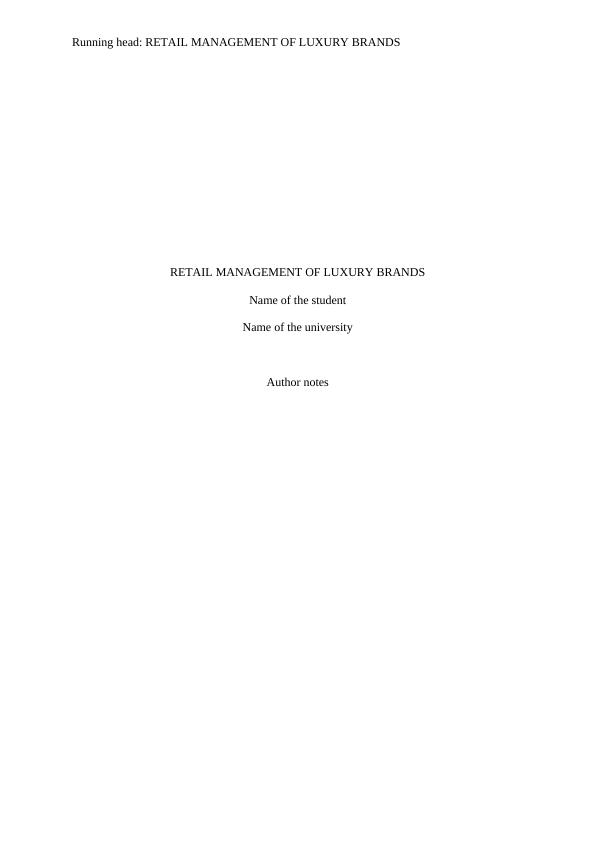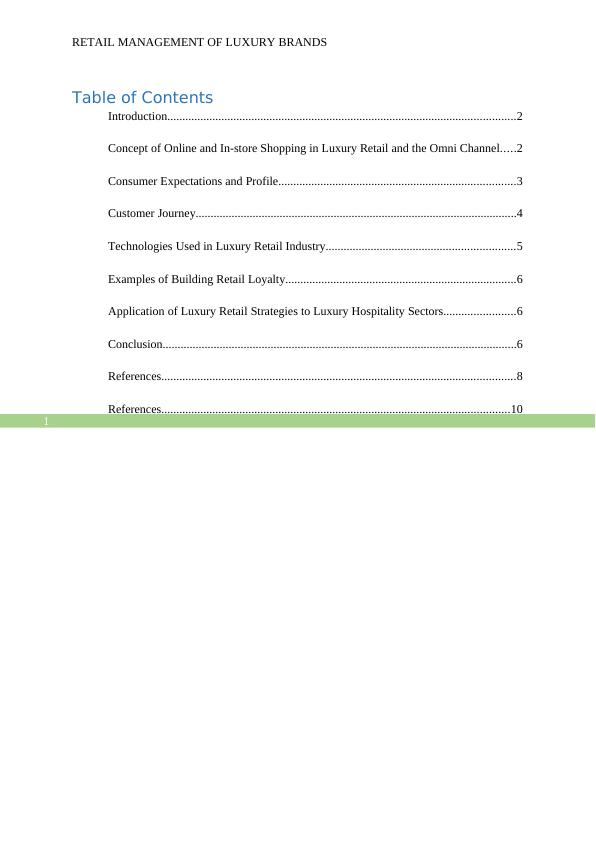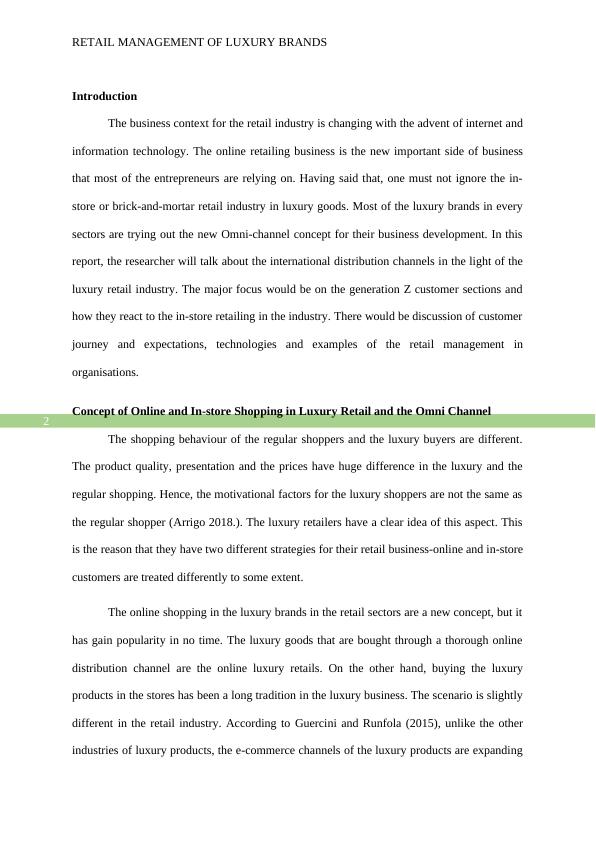Retail Management of Luxury Brands
Added on 2022-08-26
12 Pages2134 Words16 Views
Running head: RETAIL MANAGEMENT OF LUXURY BRANDS
RETAIL MANAGEMENT OF LUXURY BRANDS
Name of the student
Name of the university
Author notes
RETAIL MANAGEMENT OF LUXURY BRANDS
Name of the student
Name of the university
Author notes

1
RETAIL MANAGEMENT OF LUXURY BRANDS
Table of Contents
Introduction....................................................................................................................2
Concept of Online and In-store Shopping in Luxury Retail and the Omni Channel.....2
Consumer Expectations and Profile...............................................................................3
Customer Journey...........................................................................................................4
Technologies Used in Luxury Retail Industry...............................................................5
Examples of Building Retail Loyalty.............................................................................6
Application of Luxury Retail Strategies to Luxury Hospitality Sectors........................6
Conclusion......................................................................................................................6
References......................................................................................................................8
References....................................................................................................................10
RETAIL MANAGEMENT OF LUXURY BRANDS
Table of Contents
Introduction....................................................................................................................2
Concept of Online and In-store Shopping in Luxury Retail and the Omni Channel.....2
Consumer Expectations and Profile...............................................................................3
Customer Journey...........................................................................................................4
Technologies Used in Luxury Retail Industry...............................................................5
Examples of Building Retail Loyalty.............................................................................6
Application of Luxury Retail Strategies to Luxury Hospitality Sectors........................6
Conclusion......................................................................................................................6
References......................................................................................................................8
References....................................................................................................................10

2
RETAIL MANAGEMENT OF LUXURY BRANDS
Introduction
The business context for the retail industry is changing with the advent of internet and
information technology. The online retailing business is the new important side of business
that most of the entrepreneurs are relying on. Having said that, one must not ignore the in-
store or brick-and-mortar retail industry in luxury goods. Most of the luxury brands in every
sectors are trying out the new Omni-channel concept for their business development. In this
report, the researcher will talk about the international distribution channels in the light of the
luxury retail industry. The major focus would be on the generation Z customer sections and
how they react to the in-store retailing in the industry. There would be discussion of customer
journey and expectations, technologies and examples of the retail management in
organisations.
Concept of Online and In-store Shopping in Luxury Retail and the Omni Channel
The shopping behaviour of the regular shoppers and the luxury buyers are different.
The product quality, presentation and the prices have huge difference in the luxury and the
regular shopping. Hence, the motivational factors for the luxury shoppers are not the same as
the regular shopper (Arrigo 2018.). The luxury retailers have a clear idea of this aspect. This
is the reason that they have two different strategies for their retail business-online and in-store
customers are treated differently to some extent.
The online shopping in the luxury brands in the retail sectors are a new concept, but it
has gain popularity in no time. The luxury goods that are bought through a thorough online
distribution channel are the online luxury retails. On the other hand, buying the luxury
products in the stores has been a long tradition in the luxury business. The scenario is slightly
different in the retail industry. According to Guercini and Runfola (2015), unlike the other
industries of luxury products, the e-commerce channels of the luxury products are expanding
RETAIL MANAGEMENT OF LUXURY BRANDS
Introduction
The business context for the retail industry is changing with the advent of internet and
information technology. The online retailing business is the new important side of business
that most of the entrepreneurs are relying on. Having said that, one must not ignore the in-
store or brick-and-mortar retail industry in luxury goods. Most of the luxury brands in every
sectors are trying out the new Omni-channel concept for their business development. In this
report, the researcher will talk about the international distribution channels in the light of the
luxury retail industry. The major focus would be on the generation Z customer sections and
how they react to the in-store retailing in the industry. There would be discussion of customer
journey and expectations, technologies and examples of the retail management in
organisations.
Concept of Online and In-store Shopping in Luxury Retail and the Omni Channel
The shopping behaviour of the regular shoppers and the luxury buyers are different.
The product quality, presentation and the prices have huge difference in the luxury and the
regular shopping. Hence, the motivational factors for the luxury shoppers are not the same as
the regular shopper (Arrigo 2018.). The luxury retailers have a clear idea of this aspect. This
is the reason that they have two different strategies for their retail business-online and in-store
customers are treated differently to some extent.
The online shopping in the luxury brands in the retail sectors are a new concept, but it
has gain popularity in no time. The luxury goods that are bought through a thorough online
distribution channel are the online luxury retails. On the other hand, buying the luxury
products in the stores has been a long tradition in the luxury business. The scenario is slightly
different in the retail industry. According to Guercini and Runfola (2015), unlike the other
industries of luxury products, the e-commerce channels of the luxury products are expanding

3
RETAIL MANAGEMENT OF LUXURY BRANDS
rapidly. Luxury brands are the one that have authenticity at the heart and have a back story of
their own. The luxury retail buyers are mostly in search of unique and innovation product
associated with a brand name to trust.
The luxury retail brand are now trying to implement the omni-channel retail
distribution to attract the generation Z along with other customers. This is the distribution
channel in which the both online and in-store buying options are available to the consumers.
Consumer Expectations and Profile
The expectation and customer loyalty are the two aspects of business that the luxury
retailers take seriously. The demand of the customers changes according to their preferred
medium of buying products. The market researches show that the common tendency of the
luxury goods buyer is to buy products in the store. The consumers of online and in-store
platforms also expect different types of experience while buying the product (Crewe 2016).
First if we talk about the in-store customers, most of them are tend to have a tacit buying
experience and personalised customers’ services. This section of buyer always prefer to visit
the stores in order to see the product personally and then buy it. The on-store experience
provided by the managers or the representatives while narrating the features are another
motivating factor for their buying (Arrigo 2015). Usually these customers are within the age
group of 25 to 60 and above. The section of customers have a high end taste and prefer to buy
high-priced products. The socio-economic status of the customers are high and they prefer
personalised and elevated experience in their lifestyles.
On the other hand, the generation Z or the people under the age of 20 or below prefer
to buy everything through online channels. According to Cho and Lee (2017), they prefer to
analyse the product quality, price and designs through the online platforms or websites. The
buying experience for these customers have to be easy and tension free. They prefer to be
RETAIL MANAGEMENT OF LUXURY BRANDS
rapidly. Luxury brands are the one that have authenticity at the heart and have a back story of
their own. The luxury retail buyers are mostly in search of unique and innovation product
associated with a brand name to trust.
The luxury retail brand are now trying to implement the omni-channel retail
distribution to attract the generation Z along with other customers. This is the distribution
channel in which the both online and in-store buying options are available to the consumers.
Consumer Expectations and Profile
The expectation and customer loyalty are the two aspects of business that the luxury
retailers take seriously. The demand of the customers changes according to their preferred
medium of buying products. The market researches show that the common tendency of the
luxury goods buyer is to buy products in the store. The consumers of online and in-store
platforms also expect different types of experience while buying the product (Crewe 2016).
First if we talk about the in-store customers, most of them are tend to have a tacit buying
experience and personalised customers’ services. This section of buyer always prefer to visit
the stores in order to see the product personally and then buy it. The on-store experience
provided by the managers or the representatives while narrating the features are another
motivating factor for their buying (Arrigo 2015). Usually these customers are within the age
group of 25 to 60 and above. The section of customers have a high end taste and prefer to buy
high-priced products. The socio-economic status of the customers are high and they prefer
personalised and elevated experience in their lifestyles.
On the other hand, the generation Z or the people under the age of 20 or below prefer
to buy everything through online channels. According to Cho and Lee (2017), they prefer to
analyse the product quality, price and designs through the online platforms or websites. The
buying experience for these customers have to be easy and tension free. They prefer to be

End of preview
Want to access all the pages? Upload your documents or become a member.
Related Documents
Key issues faced by industrylg...
|1
|1066
|93
This particular strategy of omnichannellg...
|7
|1530
|10
Omni-channel Retail Marketinglg...
|18
|5493
|41
Trends in Retail: Analysis and Recommendations for Zaralg...
|9
|2474
|37
Digital Landscape Insights (Part 1)lg...
|10
|2808
|88
E-Business Applications Marks & Spencer Contents Introduction 2 Marks & Spencer Retail Digital Disruptionlg...
|5
|725
|269
